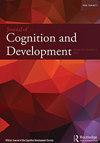5到7岁的孩子对房间空间结构的记忆有多好?
IF 2.1
2区 心理学
Q3 PSYCHOLOGY, DEVELOPMENTAL
引用次数: 0
摘要
相对较少的研究直接考察了儿童对房间大小环境中基于物体的空间结构的记忆。本研究探讨了儿童如何记忆房间的空间结构,以及图像工作记忆(WM)和不同测试视角在这一过程中的作用。实验1:80名5 ~ 7岁的幼儿参与了空间结构记忆任务、图像空间WM任务和语言能力测试。在第一个任务中,参与者探索一个方形的虚拟房间,每面墙都与不同的物体相关联。虚拟房间是在桌面显示器上看到的。然后,他们回忆相对于参考墙的不同角度(0度、90度、180度)的墙壁场景。结果发现,在考虑了年龄和语言能力的影响后,图像WM预测了空间结构的记忆。从完成任务的角度来看,孩子们很少犯以自我为中心的错误。此外,空间结构的记忆与视角无关,90度和180度条件下的表现没有差异。我们重复了实验2的基本结果,在实验2中,77个孩子完成了同样的任务,只是虚拟房间是圆形的。此外,空间结构记忆的发展轨迹作为图像WM的函数在不同的实验和视角条件下是不同的。总之,我们的研究表明,5-7岁的儿童可以从不同的角度检索房间大小环境的空间结构,这也容易受到图像WM能力、视角和几何线索的影响。本文章由计算机程序翻译,如有差异,请以英文原文为准。
How Well Do 5- to 7- Year-Old Children Remember the Spatial Structure of a Room?
ABSTRACT Relatively few studies have directly examined children’s memory of object-based spatial structure of room-sized environments. The current study investigated how children remember the spatial structure of a room, and the role of pictorial working memory (WM) and different testing perspectives in this process. In Experiment 1, 80 children aged 5 to 7 years old participated in a memory of spatial structure task, a pictorial spatial WM task, and a verbal ability test. In the first task, participants explored a square-shaped virtual room where each wall was associated with different objects. The virtual room was viewed on a desktop monitor. Then they recalled wall scenes of different perspectives (0, 90, 180 degrees) relative to a reference wall. Results found that pictorial WM predicted memory of spatial structure after accounting for age and verbal ability. Different from perspective taking tasks, children rarely made egocentric errors. Moreover, the memory of spatial structure is perspective independent because there was no difference in performance between the 90 and 180 degrees conditions. We replicated the basic results in Experiment 2, where 77 children completed the same set of tasks except that the virtual room was round-shaped. Furthermore, the developmental trajectories of memory of spatial structure as a function of pictorial WM varied between different experiments and perspective conditions. Together, our study showed that children aged 5–7 years old could retrieve the spatial structure of a room-sized environment from diverse perspectives, which was also susceptible to pictorial WM capacity, perspectives, and geometric cues.
求助全文
通过发布文献求助,成功后即可免费获取论文全文。
去求助
来源期刊

Journal of Cognition and Development
Multiple-
CiteScore
4.00
自引率
0.00%
发文量
29
期刊介绍:
The Journal of Cognition and Development is the official journal of the Cognitive Development Society (CDS). Some CDS members are concerned with basic research or theory; others focus on policy issues and practical applications. The range of interests includes cognitive development during all stages of life, and we seek to understand ontogenetic processes in both humans and nonhumans. Finally, their interests encompass typical as well as atypical development, and we attempt to characterize both biological and cultural influences on cognitive change and continuity.
 求助内容:
求助内容: 应助结果提醒方式:
应助结果提醒方式:


